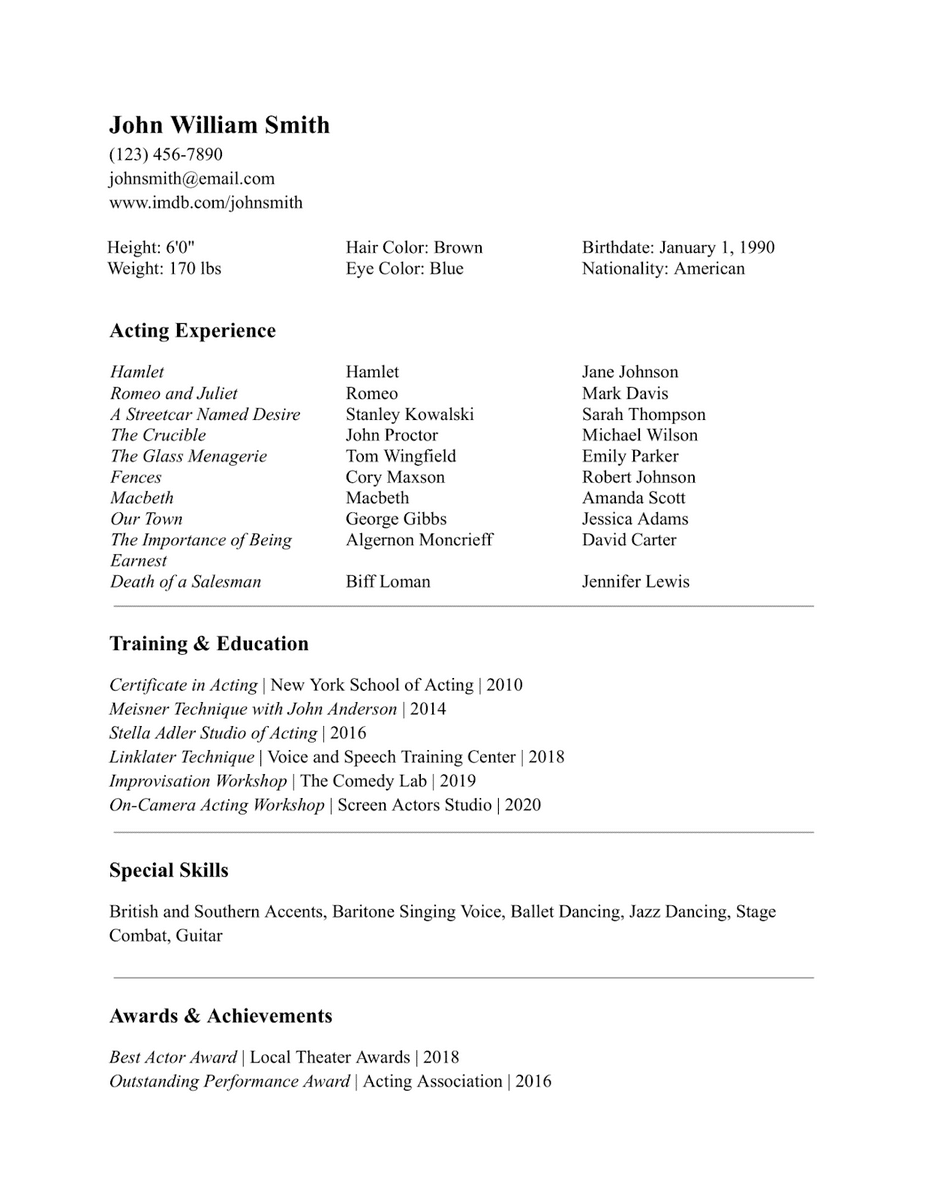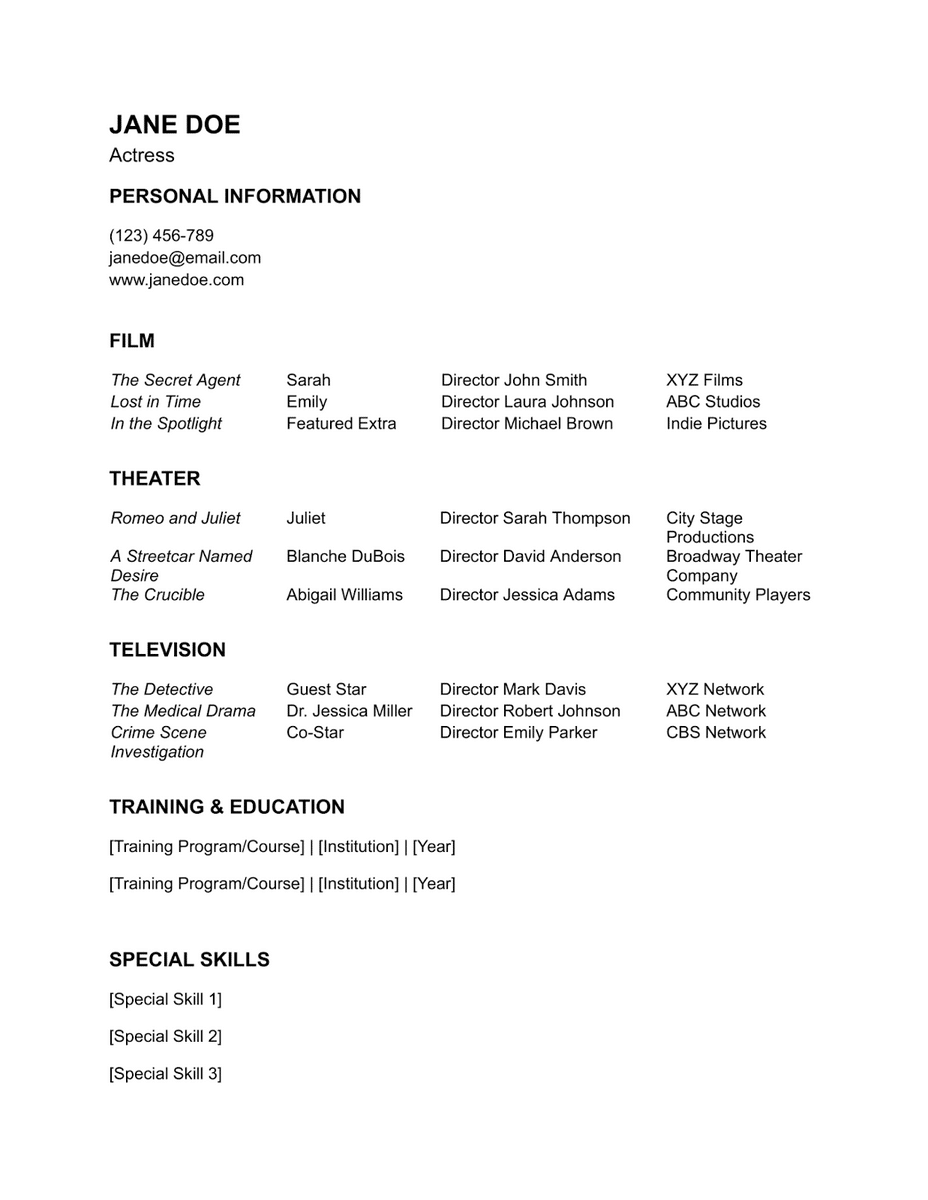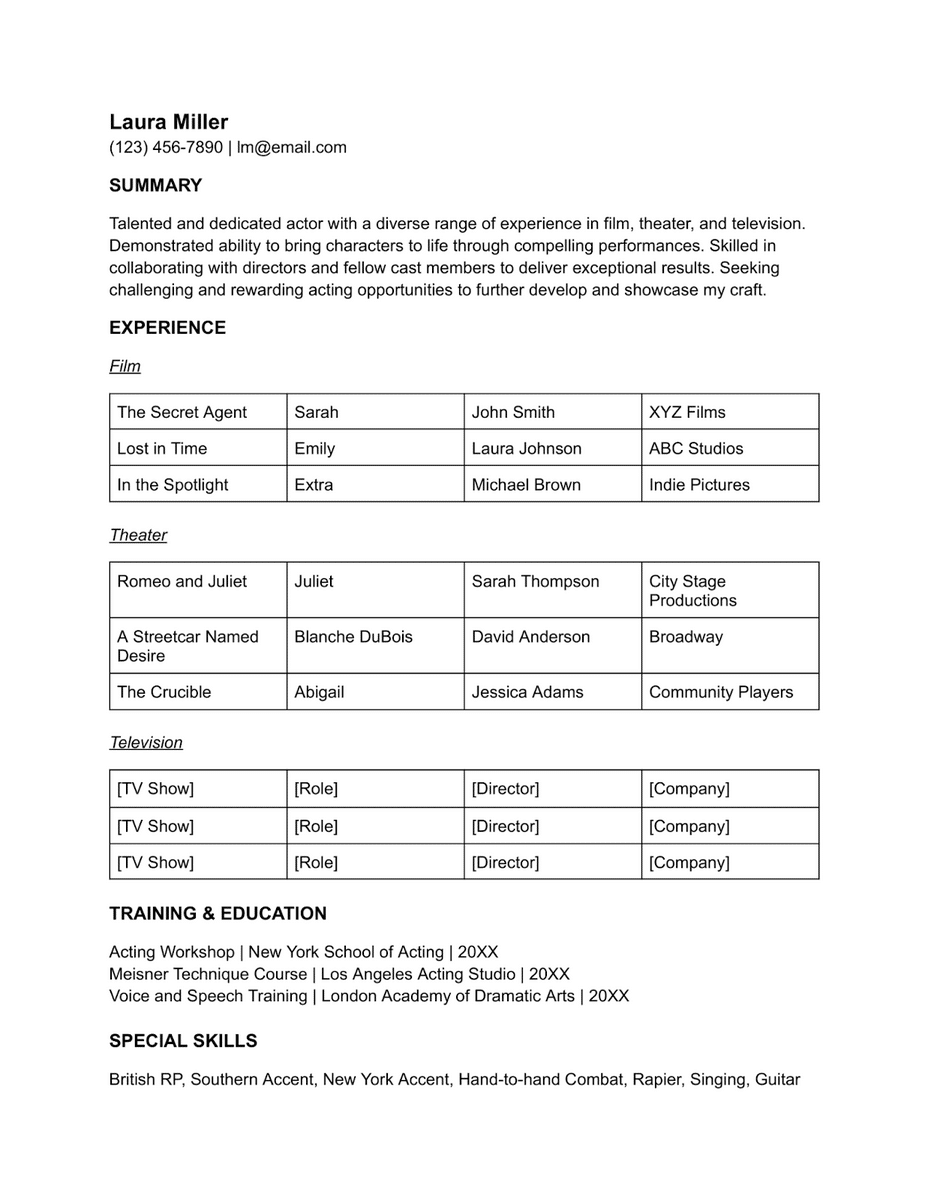Are you looking to create your theater actor resume or showcase your diverse acting experience in a well-structured format? If so, read on as we delve into some of the best-acting resume templates in Google Docs.
Table of Contents
Best Acting Resume Templates in Google Docs
Here are some of the best Google Docs acting resume templates to use in 2024:
1. Theater Resume Template in Google Docs

Are you interested in learning how to make a theater resume? Look no further! This template showcases one of the best theater resume template examples that you can use as a reference.
It includes sections where you can provide a physical description of yourself (height, weight, and notable features.), list your previous acting roles, mention the training classes you’ve taken, and highlight any special skills or awards you’ve received.
2. Simple Acting Resume Template

Do you have a wealth of acting experience to showcase? This basic theatrical resume template could be just what you’re looking for!
It allows you to categorize your previous acting work into multiple sections, such as film, television, and theater. And better yet, it helps to organize and present your experience in a clean and organized manner.
3. Actor Resume Template in Google Docs With Summary

While some individuals in the industry choose to skip the summary section in their acting resumes, there’s no reason why you can’t include one in yours. Utilize this section to emphasize your achievements and experience. This way, you can help hiring managers get the gist of your details more quickly.
Why Use Our Templates?
You can easily set up your theatrical resume on Google Docs by getting a copy of our templates. All you need to do is personalize the fields with your information. We have also ensured that these Google Docs acting resume templates adhere to industry standards to increase the likelihood of your resume getting noticed.
What To Include in an Acting Resume Template
Already got a template? Here are some essential details you should include in your acting resume:
1. Personal Details
This is the most basic component of your theatre actor resume. Make sure to include the following information:
- Full name
- Permanent address
- Primary phone number
- Secondary phone number
- Professional email address
- IMDB profile (if applicable)
Including your physical appearance details in your resume might also be worthwhile because they can serve as supporting descriptions for your headshot. Consider including the following information:
- Birthdate
- Race
- Eye color
- Hair color
- Weight
- Height
Including these details helps casting directors and agents understand your physical attributes better.
2. Acting Experience
When listing your acting experiences, starting with the most recent ones is essential by arranging them chronologically. Then, group them according to their type, such as television, theater, and film.
Finally, ensure that each entry specifies your role, the production title, and the director’s name. This provides clarity and makes it easier for casting directors and industry professionals to understand your experience.
3. Training and Education
List any acting-related training you received, including master classes, seminars, and one-on-one coaching.
Make sure to indicate the names of your mentors and the acting schools you’ve been to. There’s no need to put the dates of when you trained here, but you can indicate them for relevant training you’ve completed in the past two to three years.
4. Special Skills and Awards
Highlight any awards you have received, noting the organization or entity that presented the award, the specific category or achievement, and the year of recognition. You can also showcase any relevant skills that enhance your versatility and are relevant to your desired role. This allows casting directors and industry professionals to comprehensively understand your accolades and unique abilities.
5. Professional Headshot
A strong theatre-acting resume includes a professionally taken headshot that captures your personality. Your headshot can be in one of two ways:
- Close-up: This headshot focuses on your face, highlighting your facial expressions and features.
- Full-body or upper-body: This headshot includes your face and upper body, providing a broader view of your physical appearance.
Print your headshot separately on 8″ by 10″ paper. Then, attach it to the back of your resume with staples. This ensures that your headshot remains securely attached and easily accessible to casting directors and industry professionals.
Common Mistakes to Avoid in Your Acting Resume
Increase your chances of getting picked by avoiding the following mistakes in your theater actor resume:
1. Not Sending Your Resume in PDF
When sending resumes in an editable format, such as MS Word or Google Docs, there is a risk of encountering formatting issues. To preserve the formatting of your resume, it is recommended to convert your theatre actor resume into PDF format before sending it to hiring managers. This ensures the document appears consistent across different devices and operating systems.
If you insist on sending your resume using the link-sharing function in Google Docs, make sure that you set the permissions to “Viewer” only. This will prevent anyone with access to the document from editing its contents
2. Using Inappropriate Fonts
If you use funky fonts like Jokerman and Wingdings, don’t expect any casting director to take you seriously. Using such unprofessional fonts when auditioning for a role is highly discouraged.
Instead, use professional-looking typefaces like Times New Roman, Arial, and even Calibri in your resume. These fonts are widely accepted and commonly used in professional settings, giving your resume a polished and professional appearance.
3. Unclear Section Headings
It is standard practice to divide your resume details into multiple sections. This approach enhances readability and creates a sense of organization.
When using section headings, ensure that they are clearly visible and distinguishable. This helps hiring managers and readers navigate through your resume more easily and understand the structure of your information.
4. Colorful Themes
As much as possible, avoid using colors on your resume. This is because casting directors or hiring managers may print your resume in black and white, making certain parts of your resume unreadable if they rely on color for emphasis or clarity.
Keeping your resume in a simple black-and-white theme ensures that the content, such as your experience, skills, and other details, remains the focus. This approach is appropriate and enhances the overall professionalism of your resume.
5. Printing Your Resume on the Back of Your Headshot
While it is true that some actors choose to print their resumes directly on the back of their headshots, it is generally not recommended to follow this practice. Many hiring managers prefer to receive the resume and headshot separately.
By keeping them separate, you have the flexibility to update your theatre acting resume more easily when necessary. This also allows you to change your resume without reprinting your entire headshot.
6. Using Multiple Columns
Avoid using multiple columns and vertical formatting in your resume. This isn’t standard practice and gives the impression that you didn’t think about your resume layout.
Always stick to the traditional horizontal layout that goes from margin to margin. It’s easier to read and makes your resume look more professional.
Frequently Asked Questions
How Can You Make Your Resume Stand Out from Those of the Other Applicants?
Appearance-wise, you want to keep your resume clean and visually appealing by using easy-to-read fonts. Additionally, when it comes to the content of your resume, it is crucial to customize it to the specific role you are auditioning for. This can be done by emphasizing relevant experience and skills aligning with the desired role.
You can also showcase standout roles, unique talents, and any industry recognition you have received. By tailoring your resume in this way, you increase your chances of capturing the attention of casting directors and demonstrating your suitability for the role.
How Long Should Your Acting Resume Be?
Limiting your acting resume to one page is considered an industry standard. To adhere to this guideline, omit any irrelevant details from your resume.
Additionally, print your headshot separately from your one-page resume. This gives you more space to showcase any relevant action experience while also being the preference among casting directors.
What’s the Best Kind of Actor Resume Template to Use?
Use a clean and professionally designed actor resume template that effectively showcases your experience, skills, and training. It should use only black and white colors, employ standard fonts such as Arial and Times New Roman, and incorporate well-defined section headings.
Final Thoughts
Ready to create a compelling actor’s resume? Simply use one of our acting resume templates in Google Docs, and you’re good to go.
If you’re looking for more advanced templates to streamline your work, check out our premium templates today! Then take advantage of our special offer and enjoy up to 50% off using the promo code “SSP.”
Related:
- Get a Free Cover Letter Template for Google Docs (7 Styles)
- Download a Free Google Docs Resume Template (8 Styles)
- SMART Goals Template for Google Docs [3 Free Options]




